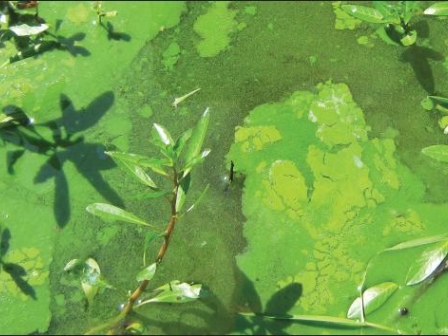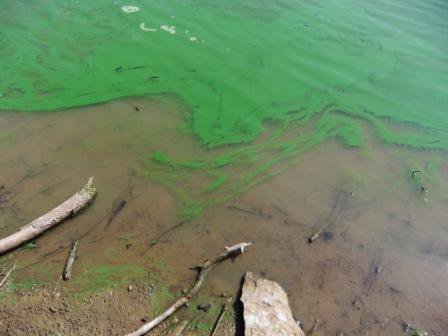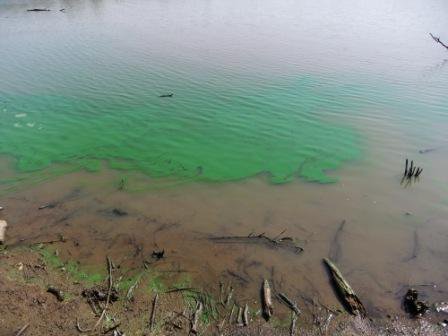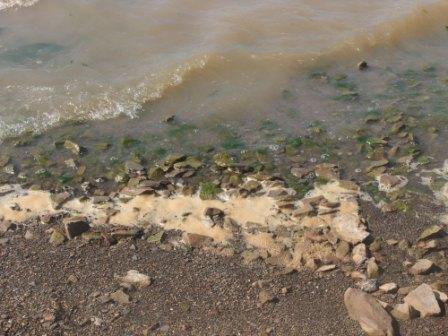With more than 200 lakes and over one million surface acres of water for boating and swimming, Oklahoma has been a haven for water recreation. In recent years, Oklahoma and other states have been impacted by various naturally occurring environmental conditions. Learn how to keep you and your family safe on Oklahoma?s waterways and find answers to all of your questions about swimming and water safety here.
Simply browse this section for frequently asked questions, water safety tips, lake updates, blue-green algae identification tips and more. Before you pack up the car and head to your lakeside destination, choose your lake from the drop-down menu below to view the most up-to-date lake conditions and testing results.
Click here for Primary Amebic Meningoencephalitis (PAM) information.
Blue-green algae can be found in many types of waterways such as lakes, ponds, creeks and rivers. Learn to identify blue-green algae and protect yourself by avoiding water that is discolored, or where foam or scum is present.



Though blue-green algae can occur in small amounts not visible to the human eye, large blooms often resemble blue-green paint that has been spilled in the water. Be on the lookout for foam, scum or mats that float on the surface of the water, or a pea soup-like substance.



Mats of blue-green algae can be blown across the lake surface by winds and wash up onto the shore. These shoreline mats can be even more concentrated, and therefore, potentially more toxic than algae blooms in the water.


Blue-green algae blooms can be blue, bright green, brown or even red. As the algae in blooms die, the water may also have an unpleasant odor.


Blue-green algae (BGA) consists of tiny bacterial organisms that can live in all types of water including lakes, streams and ponds. BGA is usually found in low numbers, but can become abundant in certain conditions like warm, stagnant water, heavy sunlight and areas that have recently had a change in chemicals, such as nitrogen from fertilizer. BGA is also known as cyanobacteria.
BGA has been around forever. The bacteria have been found among the oldest fossils on Earth and are one of the largest groups of bacteria. Algae are vitally important to water ecosystems, and most species of algae are not harmful.
When BGA grows very thick and dense, it is called a bloom. Most BGA blooms are completely harmless; however, the blooms can turn toxic in a short amount of time, so all BGA are considered potentially harmful. Not all BGA blooms can be seen by the naked eye.
Though BGA can bloom at any time of the year, it is most active during the summer and fall. Most of the time, when algae blooms, it produces a thick mat of scum on the water's surface and shoreline. The scum can range in color from blue and green to red and brown. The scum from BGA can sometimes look like a paint spill. When the bloom dies, it can smell similar to rotting plants.
Some BGA produce nerve toxins (neurotoxins) or liver toxins (hepatotoxins), as well as toxins that affect the skin and gastrointestinal tract. The toxins can be present in the algae or in the water. You cannot tell if a bloom is toxic by looking at it.
Use our lake conditions search function to find the latest BGA reports for the lake you are planning to visit. Additionally, BGA can sometimes be identified by the naked eye. BGA may look like green, blue, red or brown paint floating in the water. When BGA builds up, it can float to the shore and look like a thick mat. Keep in mind that not all BGA are visible, as it can bloom 1-3 feet below the surface and can only be identified using a microscope.
The toxins produced by BGA may cause a variety of reactions, including upper respiratory problems, eye irritation, vomiting and diarrhea. Any contact with BGA can be harmful, so you should avoid all body contact where BGA is present.
If you, your family or your pets have come in contact with water where BGA is present, seek immediate medical assistance. Children are particularly vulnerable to BGA as they tend to weigh less than adults and smaller quantities of the toxins may trigger a more severe effect.
Yes. Pets are particularly susceptible to the harmful effects of BGA. If pets eat, drink or swim in BGA affected waters, it can lead to severe illness and even death. If your pet has been exposed to BGA, contact your veterinarian or an emergency animal clinic.
BGA produce two kinds of toxins that affect humans and animals. In humans, exposure to nerve toxins may produce tingling in fingers and toes, numbness in the lips and dizziness. In animals, neurotoxin poisoning can cause weakness, staggering, difficulty in breathing, convulsions and death.
The second kind of toxin, liver toxins, can take hours or days to appear. Liver toxins can cause abdominal pain, diarrhea and vomiting in humans, and can cause death in animals.
Seek medical treatment immediately and notify your doctor/veterinarian about the exposure.
When possible, it is best to swim in a regulated beach area where safety and health notices will be posted. Contact with water not visibly affected by BGA is not expected to cause health effects. After visiting a lake, humans and animals should shower with clean water and wash thoroughly. Remember, not all BGA is visible to the human eye. Please use good judgment in deciding whether or not to swim in the lake.
The testing varies by lake. For the most up-to-date information on water testing, select your lake from the drop-down menu on the lake conditions page to see the most recently reported information
The Grand River Dam Authority (GRDA) monitors Grand Lake, Lake Hudson and W.R. Holway sites once each month from October through April and twice a month from May through September. If any of the sites show an elevated risk of BGA, they will be tested once a week until the advisory is gone.
The City of Oklahoma City tests Lakes Hefner, Overholser and Draper on a weekly basis.
The City of Tulsa monitors Oologah Lake, Lake Eucha, Spavinaw Lake and Lake Hudson on either a weekly or monthly basis.
Other Oklahoma lakes are monitored by various sources and reports are funneled into our database.
Use our lake conditions search function to find the latest BGA reports for the lake you are planning to visit. You can also search TravelOK.com for the page about the lake you wish to visit and contact lake personnel directly at the phone number listed. Ultimately, it is your responsibility to decide if visiting the lake is safe.
If you see a BGA bloom, avoid all contact with the water. Keep children, pets and livestock away from the water.
To report BGA, contact the Oklahoma Department of Environmental Quality at 1-800-522-0206.
Water recreation, whether you spend the day swimming, boating, diving or floating a river, can be fun for family and friends and the cornerstone of any outdoor vacation. However, water can also be dangerous and present various hazards, especially for children. Before you head out on Oklahoma's lakes and waterways, it's always a great idea to brush up on current water safety tips. Read through TravelOK.com's water safety checklist below and keep your family safe in the water!